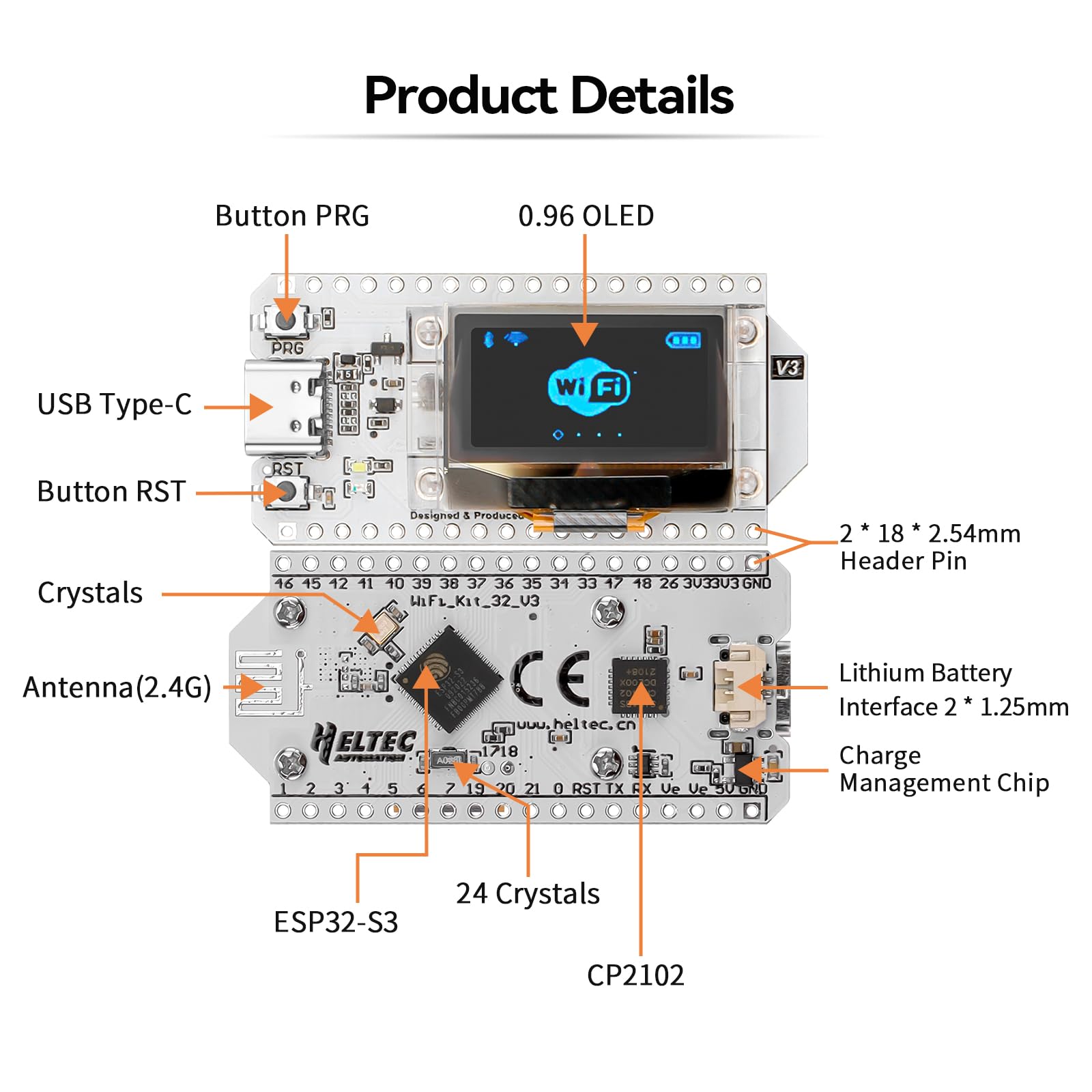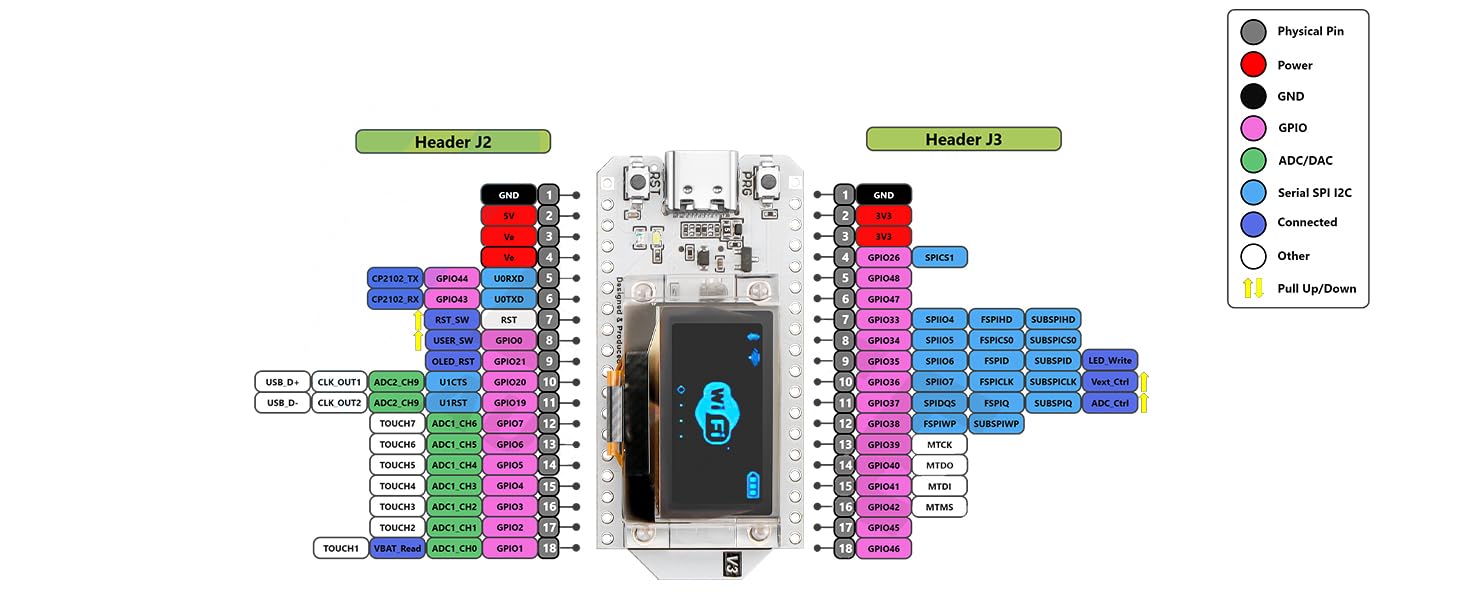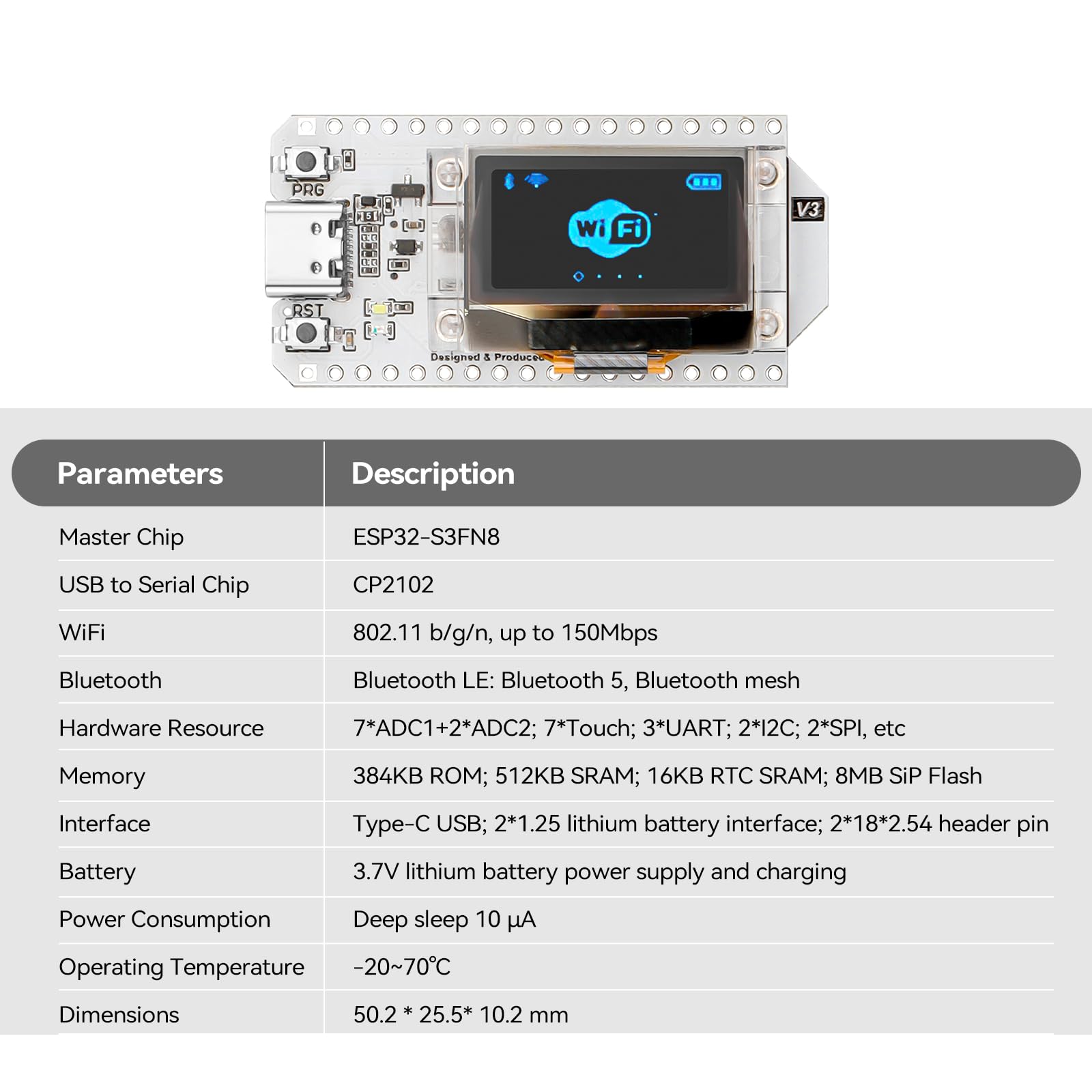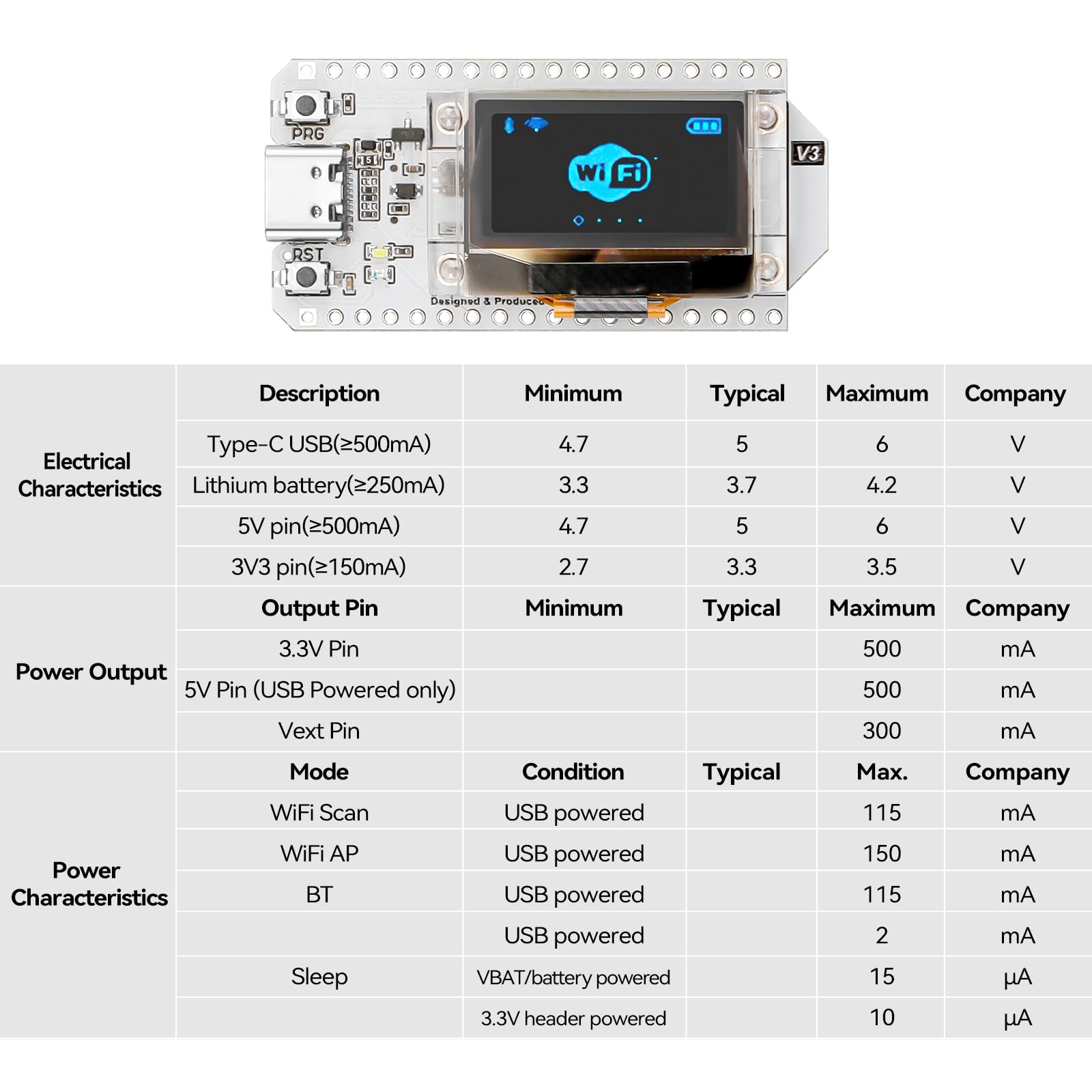








🚀 Elevate your IoT game with MakerFocus ESP32 OLED WiFi Kit V3 – where smart meets sleek!
The MakerFocus ESP32 OLED WiFi Kit V3 is a compact, highly integrated IoT development board featuring a dual-core 240 MHz ESP32 processor, onboard WiFi and Bluetooth 5 connectivity, and a 0.96-inch OLED display. Designed for seamless Arduino IDE compatibility, it includes a lithium battery management system with Type-C power input, making it ideal for smart city, home automation, and IoT maker projects.
| Processor | 240 MHz none |
| RAM | LPDDR |
| Memory Speed | 240 MHz |
| Wireless Type | 802.11abg |
| Brand | MakerFocus |
| Series | WiFi Kit 32 (V3) |
| Item model number | 8541612336 |
| Operating System | Arduino IDE (compatible with Windows, macOS, Linux), FreeRTOS (firmware) |
| Item Weight | 0.16 ounces |
| Product Dimensions | 1.97 x 1 x 0.05 inches |
| Item Dimensions LxWxH | 1.97 x 1 x 0.05 inches |
| Processor Brand | Espressif |
| Number of Processors | 2 |
| Voltage | 3.3 Volts |
| Manufacturer | MakerFocus |
| ASIN | B076KJZ5QM |
| Is Discontinued By Manufacturer | No |
| Date First Available | October 19, 2017 |
C**S
Use latest Arduino IDE and you're golden
I was trying to make this work "the right way" via ESP tools. But really, just use the Arduino IDE, it's only a couple steps and it's so easy:1) Download latest Arduino IDE2) Visit github (dot) com / espressif / arduino-esp32 and follow the directions about adding the ESP32 via board manager.3) Open Arduino IDE under menu Tools → Board there are now a ton of new boards at the bottom of the list. Choose the "Haltec WiFi kit 32" -- also Pick the right COM port.4) To get library for display: Sketch → Include Library → manage Libraries... search for u8g2 and install it.Then put this in the sketch:#include <U8g2lib.h>#include <U8x8lib.h>U8G2_SSD1306_128X64_NONAME_F_SW_I2C u8g2(U8G2_R0, /* clock=*/ 15, /* data=*/ 4, /* reset=*/ 16);// ESP32 OLED WiFi Kit onboard LED#define LED_PIN 25// ESP32 OLED WiFi Kit "PRG" button for input to programs#define PRG_BUTTON_PIN 0void setup() {u8g2.begin();u8g2.setFont(u8g2_font_6x12_mf); // fairly small fontu8g2.setFontRefHeightExtendedText();u8g2.setDrawColor(1); // normal, not invertedu8g2.setFontPosTop(); // x,y is at top of fontu8g2.setFontDirection(0); // not rotatedu8g2.drawStr(0, 0, "It Works!");u8g2.sendBuffer();}UPDATE: Still loving these! This is my new go-to MCU for development. The OLED makes debugging easy and at least there's the one "PRG" button you can watch in your sketch. I've bought more of these via a different listing and it is the same board.Oh, and don't press down REAL HARD on the face of the OLED, like trying to smash it down into another PCB ... if you do it hard enough, you can break the edge of the LCD and wreck the words showing up. :D So now I try to avoid pressing on the OLED itself. These boards are pretty tough. The soldering also isn't that hard - when near the ribbon cable for the display, hold the iron to the outside of the pin and board.Additionally, the PWM on pins 25 and 26 are super easy to set up.// pwm#define SIG_OUT 26double freq = 15.8;const int pwmChannel = 0; // This is not the output pin, that gets attached later!const int resolution = 10; // Resolution 8, 10, 12, 15 -> higher freq = less resolutionpinMode(SIG_OUT,OUTPUT);// configure LED PWM functionalititesledcSetup(pwmChannel, freq, resolution);// attach the channel to the GPIO2 to be controlledledcAttachPin(SIG_OUT, pwmChannel);// set duty cycle based on 2^10ledcWrite(pwmChannel,64);
D**2
Excelente producto y excelente servicio del vendedor 100%
Gracias a armazón y su equipo logístico hoy podemos crear nuestros proyectos de automatización en menos tiempo.Excelente servicio.100%.
A**M
I like it! It does have a few nuances though.
This board is pretty cool. I bought it for the integrated OLED diplay. Very satisfied with it despite the minor issues. If you are just starting out, you may want to pass this one up for a more seasoned board like a Huzzah. But if you like hunting down information and learning the hard way, buy it.The issues I have with this board are minor to me but worth noting. The library needs more work. if you #include heltec.h, their library for the board, and nothing else in your script other than say a basic "Hello World" to the Serial and upload your script, it will crash the device and cause it to endlessly reset. Remove heltec.h and the script runs fine. I tried grabbing their latest from their github and it's none better. Most of their examples don't work. Luckily, pretty much any ESP32/ESP8266 stuff will work with it.There are some nuances:There are only 2 PWM GPIO pins.There is no analogWrite. You can use ledcWrite and a function to set the duty cycle and it works good that way. Just need to remember to call your function, instead of just using analogWrite. Though you could probably do a pseudo duty cycle with digitalWrite and delay.The built-in OLED uses three GPIO pins. SCL is GPIO15, SDA is GPIO4, and reset is GPIO16. This makes those pins unable to be used for most other things.The only display library I managed to get to work flawlessly with the OLED display was the U8glib by olikraus. Both U8g2 and U8x8 worked just fine for me. The lib is available on github. Note that I didn't try more than a handful graphic libraries. U8glib worked and I didn't need to continue searching for another after that.This still leaves you around 20 GPIOs to use and of that amount, 8 are input only. The pins are also only 3.3v tolerant and may be damaged if you connect to 5v.The original pin out diagram they released was wrong. The side with GPIO pin 36 is on the RST button side and GPIO pin 21 is on the PRG button side. They have corrected it and the correct version is available on their github site but I also attached it to this review. You can see they just blurred the board in their updated diagram.The annoying flicker of the BAT LED. If you do not plug in a battery to the battery connector, located under the board, the BAT LED will flash constantly. There is no way to programmatically shut it off that I know of. If you know a way, please I'd love to hear from you in the comments.All in all, this is a very good project board if you have a little bit of knowledge and don't mind poking around looking for information.ADDENDUM: I wanted to add one more thing, and this is stating the obvious, I had to solder the header pins on to the board. A couple of tips I can pass along is go ahead and unscrew the four screws that hold the OLED in place so you can move it and more importantly the ribbon cable out of the way a bit. This should give you plenty of room to solder the pins without the risk of touching the ribbon cable with the soldering iron. Then just screw the four screws back in but don't tighten too much. Just snug them up should be fine. You can stick the header pins into a breadboard to hold them in place while you solder a pin on each end. Should be good to go for the rest. Mind the heat though. For whatever reason my soldering iron melted part of one plastic pin holder on the header. It still works. This was my mistake, not a design flaw.
W**Y
this is a great little dev board, but there are serious documentation shortcomings
I am going to save you some time by repeating something another reviewer already stated "Use the pin labels on the bottom of the PCB". They noticed that the doc shows the device from the bottom. I also noticed the LEDs are on the opposite side in the picture. Maybe the picture was taken in selfie mode. I burned a day on this trying to figure out why my analog inputs were working but not the digital counterparts. I've ordered three of these in the last three months. They have all been the V3 board. The pin diagram (WIFI_Kit_32(New)) seems to have the correct analog pins labeled, but the GPIO pins are outright incorrect. I believe the problem is a bit deeper than just an inverted image. The GPIO pins still don't match inverted. I think their library is configured for the back silk screen labels, but the analog pins in the diagram I mentioned above are correct. so in short; use the diagram when using analog, and the back of the device when using digital. how fun!! otherwise these things are great for the price.
Trustpilot
1 day ago
1 week ago